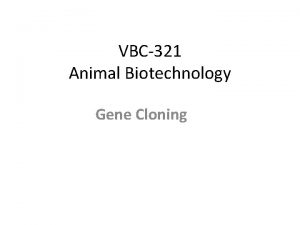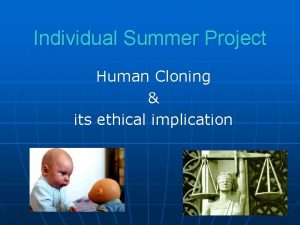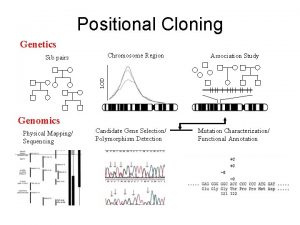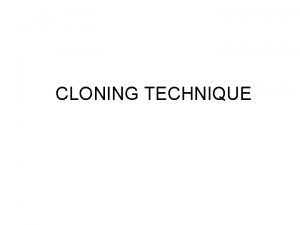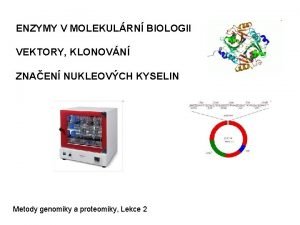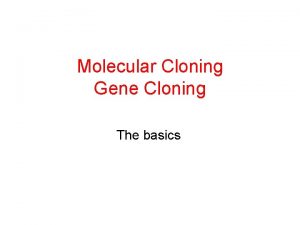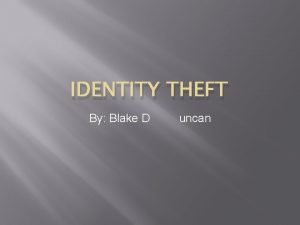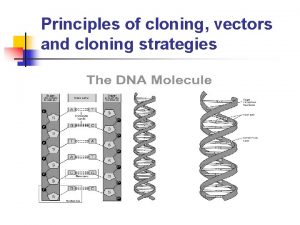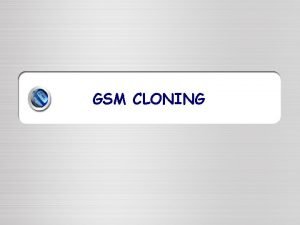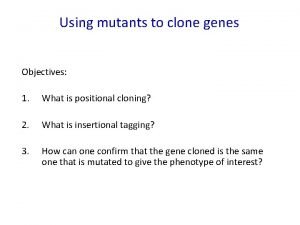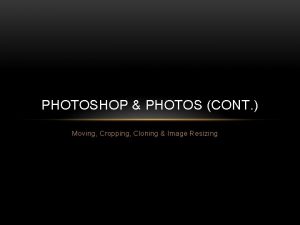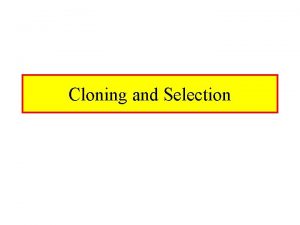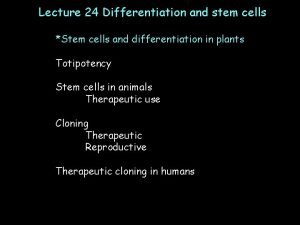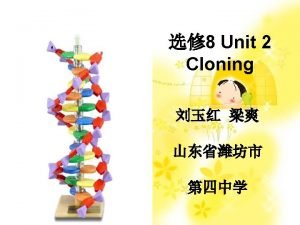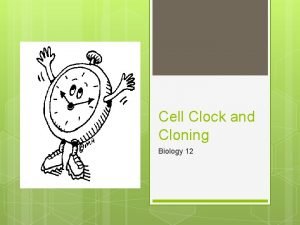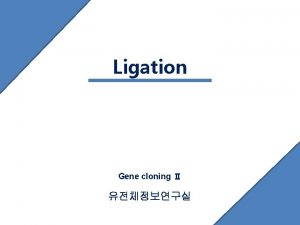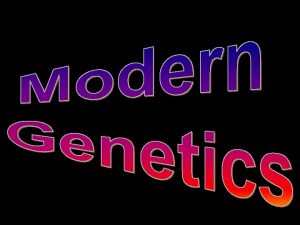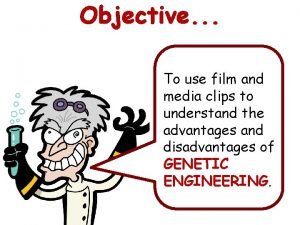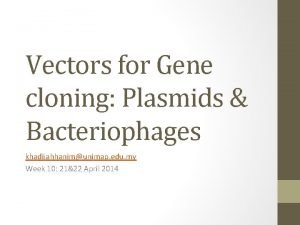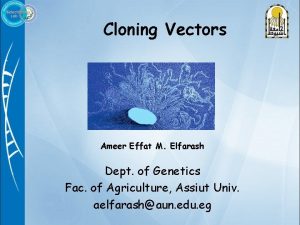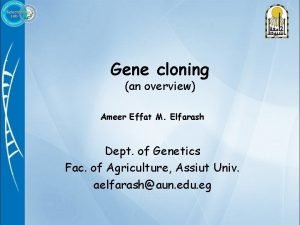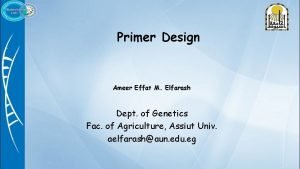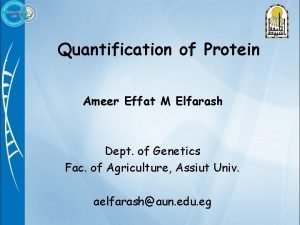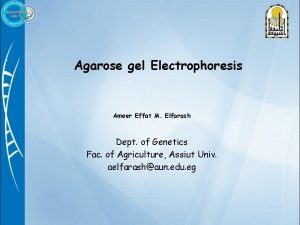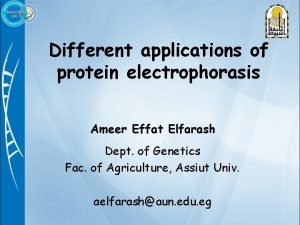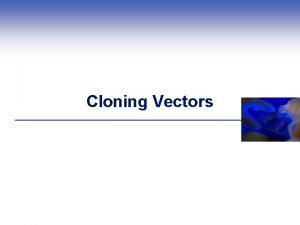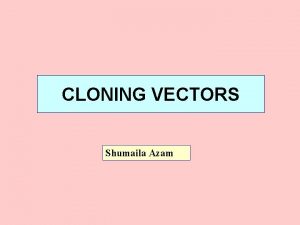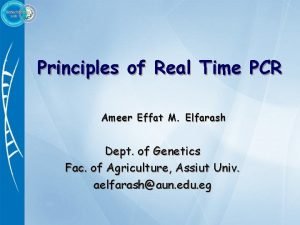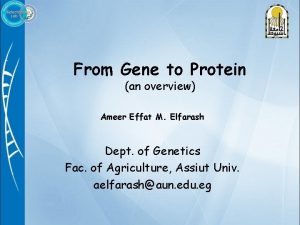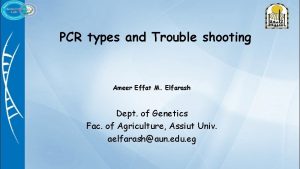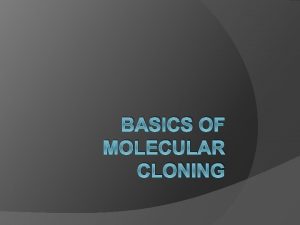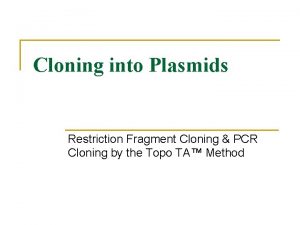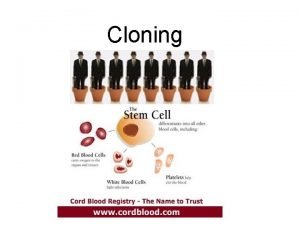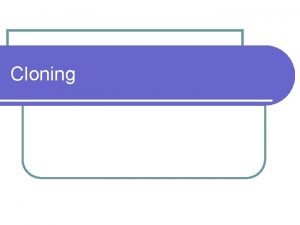Cloning Vectors Ameer Effat M Elfarash Dept of






















- Slides: 22

Cloning Vectors Ameer Effat M. Elfarash Dept. of Genetics Fac. of Agriculture, Assiut Univ. aelfarash@aun. edu. eg

CLONING VECTORS • Cloning vectors are DNA molecules that are used to "transport" cloned sequences between biological hosts and the test tube. Cloning vectors share four common properties: 1. Ability to replicate. 2. Contain a genetic marker for selection. 3. Unique restriction sites to facilitate cloning of insert DNA. 4. Minimum amount of nonessential DNA to optimize cloning.

Types of vectors • Different types of cloning vectors are used for different types of cloning experiments. • The vector is chosen according to the size and type of DNA to be cloned • • Maximum insert size (kilobases or kb [1000 bp]) 6 -12 Bacterial plasmid 25 bacteriophage 35 Cosmids 200 -1000 yeast artificial chromosome

• Bacterial plasmids Most bacterial DNA is on a single large chromosome, but some DNA is in a small circle called a plasmid.

Bacterial Plasmids in Nature Occur naturally in bacteria and usually carry genes that are useful but not essential to survival There can be as many as several hundred copies of a single plasmid in each bacteria. They can replicate independently of the host cell.

Size and copy number

PLASMID VECTORS • Plasmid vectors are used to clone DNA ranging in size from several base pairs to several thousands of base pairs (100 bp -10 kb). • Most vectors are genetically engineered. Features of many modern Plasmids • Small size • Origin of replication • Multiple cloning site (MCS) • Selectable marker genes • Expression vectors have sequences that allow RNA polymerase to transcribe genes

SELECTIVE MARKER Growing Culture Spread transformed bacterial cells on the LB plate with selection drug and grow overnight.

SELECTIVE MARKER

ORIGIN OF REPLICATION • Origin of replication is a DNA segment recognized by the cellular DNAreplication enzymes. • Without replication origin, DNA cannot be replicated in the cell.

MULTIPLE CLONING SITE • • • Many cloning vectors contain a multiple cloning site or polylinker: a DNA segment with several unique sites for restriction endo- nucleases located next to each other Restriction sites of the polylinker are not present anywhere else in the plasmid. Cutting plasmids with one of the restriction enzymes that recognize a site in the polylinker does not disrupt any of the essential features of the vector

ori • RNA polymerase promoter sequences amp. R lac. Z gene MCS




Plasmid Isolation from Bacteria Alkaline denaturation

OTHER TYPES OF CLONING VECTORS

BACTERIOPHAGE LAMBDA • Phage lambda is a bacteriophage or phage, i. e. bacterial virus, that uses E. coli as host. • Its structure is that of a typical phage: head, tail fibres. • Lambda viral genome: 48. 5 kb linear DNA with a 12 base ss. DNA "sticky end" at both ends; these ends are complementary in sequence and can hybridize to each other (this is the cos site: cohesive ends). • Infection: lambda tail fibres adsorb to a cell surface receptor, the tail contracts, and the DNA is injected. • The DNA circularizes at the cos site, and lambda begins its life cycle in the E. coli host.

BACTERIOPHAGE LAMBDA

COSMID VECTOR • The cosmid vector is a combination of the plasmid vector and the COS site which allows the target DNA to be inserted into the λ head. It has the following advantages: – High transformation efficiency. – The cosmid vector can carry up to 45 kb whereas plasmid and λ phage vectors are limited to 25 kb.

Yeast Artificial Chromosomes The yeast artificial chromosome (YAC) vector is capable of carrying a large DNA fragment (up to 200 Kb), but its transformation efficiency is very low.

 Cloning vector
Cloning vector Plasmid
Plasmid Cloning pros and cons
Cloning pros and cons Clonaid
Clonaid Genetic engineering steps
Genetic engineering steps Positional cloning
Positional cloning Reproductive cloning process
Reproductive cloning process Nick translation
Nick translation Genez molecular clones
Genez molecular clones Identity cloning and concealment
Identity cloning and concealment 5' overhang
5' overhang Gsm cloning
Gsm cloning Inverse pcr
Inverse pcr Pixpsd
Pixpsd Suspension cloning
Suspension cloning Therpeutic cloning
Therpeutic cloning Advantages of cloning
Advantages of cloning Cloning in nature
Cloning in nature Gene cloning
Gene cloning Process of cloning
Process of cloning Advantages and disadvantages of cloning
Advantages and disadvantages of cloning Clock gate cloning
Clock gate cloning Gene cloning
Gene cloning

